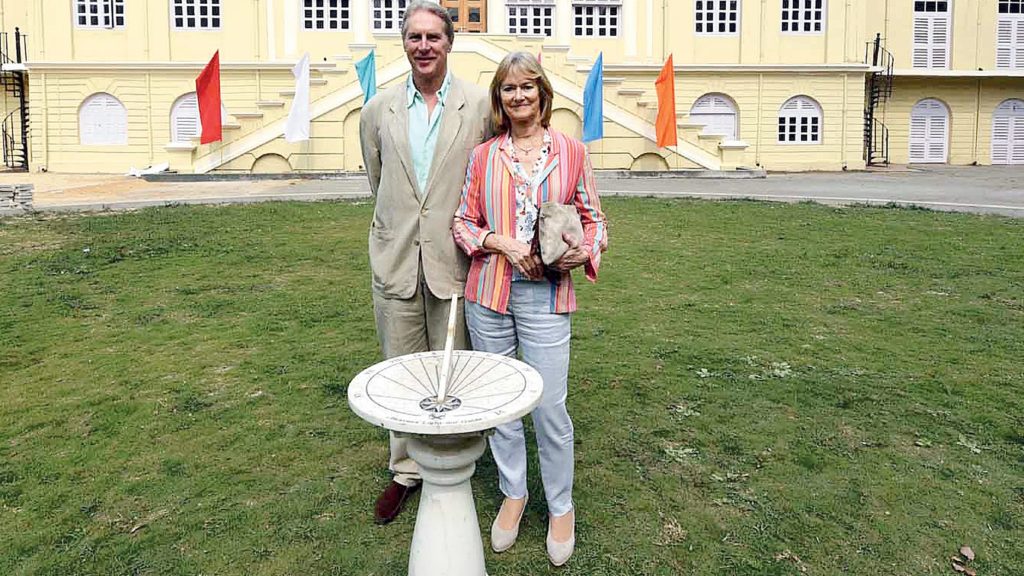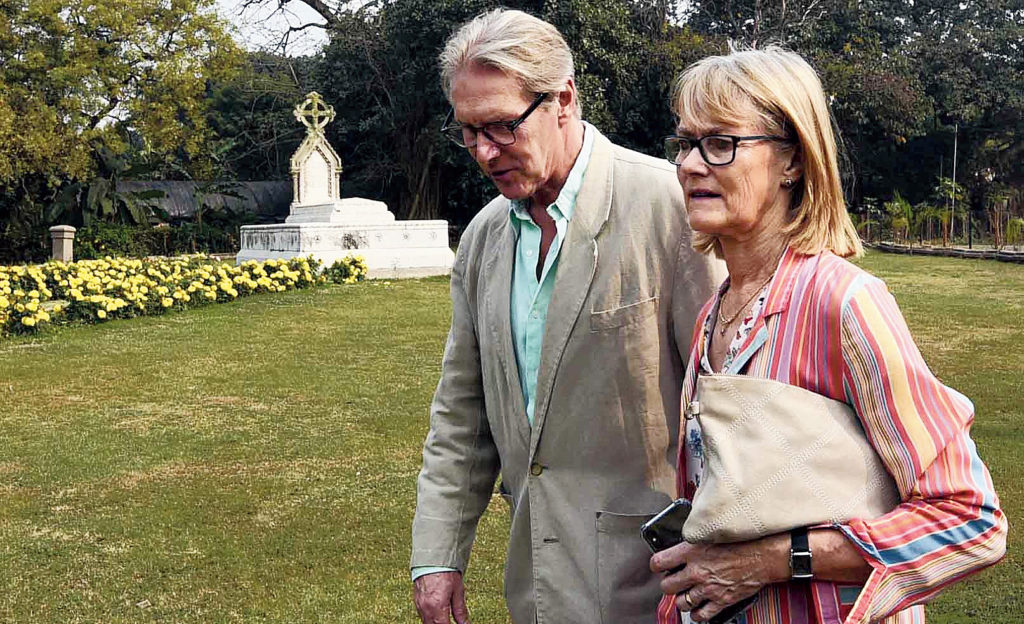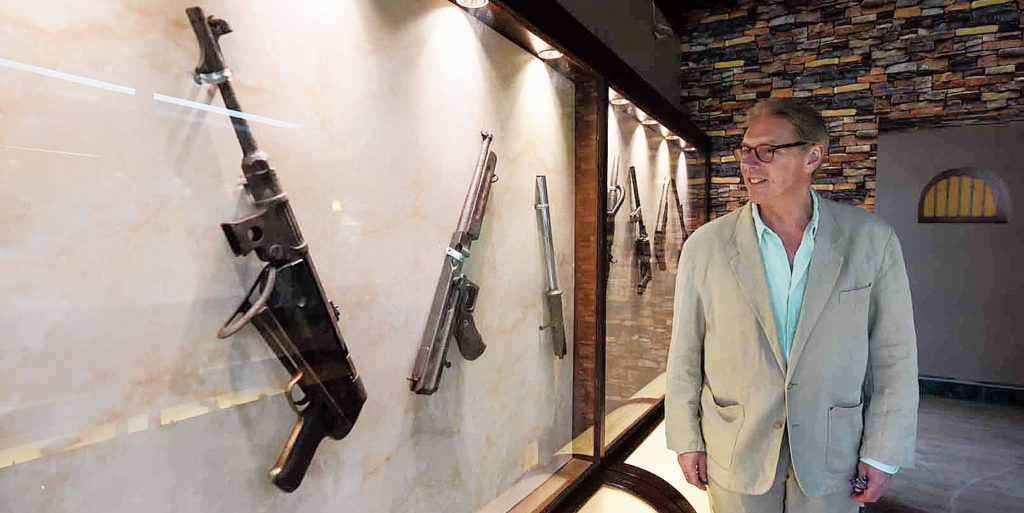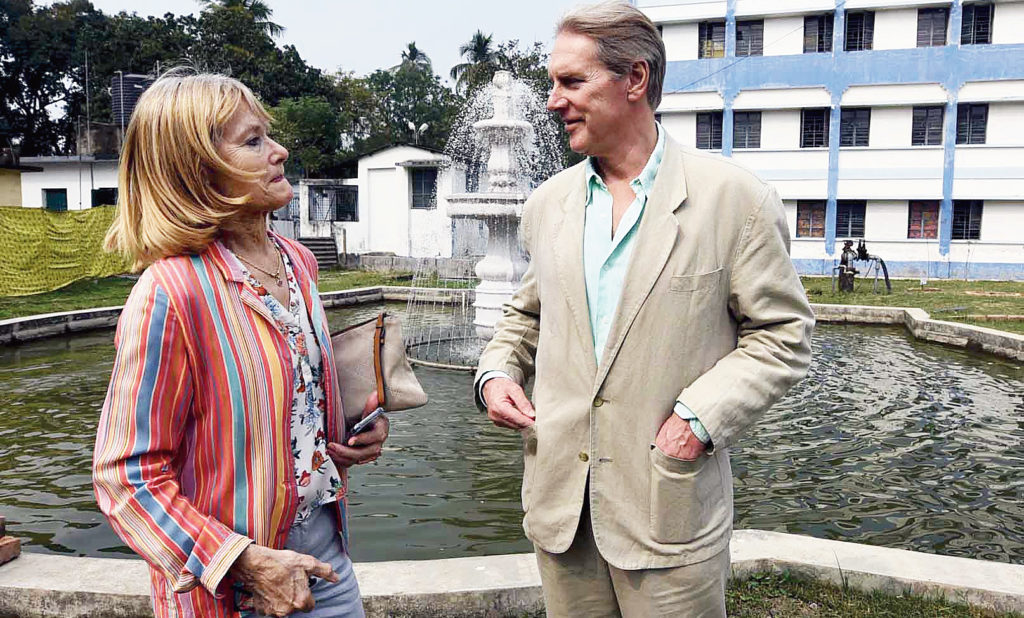A flesh-and-blood Minto and his wife were in Calcutta on Saturday, retracing the steps of his ancestors who lived here over a century ago

Gilbert Timothy George Lariston Elliot-Murray-Kynynmound, the seventh Earl of Minto, with his wife Diana Barbara Trafford in front of the Old Government House in Barrackpore on Saturday. / Pradip Sanyal
Minto, to most Calcuttans, is a bus stop scrawled in black on an yellow band across the sides of ramshackle minibuses. For some, it is the patch of green in front of Belle Vue Clinic named after the governor general of India.
But a flesh-and-blood Minto and his wife were in Calcutta on Saturday, retracing the steps of his ancestors who lived here over a century ago.
Gilbert Timothy George Lariston Elliot-Murray-Kynynmound, the seventh Earl of Minto, visited the summer residence of the governors general of India where the first Earl of Minto (governor general of India, 1807-1813) and the fourth Earl of Minto (governor general and viceroy of India, 1905-1910) are said to have spent many a happy weekend, “arriving on Fridays and leaving only on Monday mornings”.
“I can absolutely see why they built the summer residence right next to the river. It gives a real atmosphere of India, and I just spent a magical time there,” Minto told Metro after touring the Old Government House in Barrackpore.
“The entire purpose of this time was to visit Calcutta,” said Minto, on his second visit to India but “the very first to Calcutta”. He is scheduled to travel to Goa and Hyderabad before leaving for London.
Minto’s earlier stops in the city included Victoria Memorial Hall and the Raj Bhavan, where he saw a photograph of Lord Minto’s appointment as governor general in 1807.
“There was a lot of talk about India at home and the country was remembered with much affection,” said the current Lord Minto, pausing before his ancestor’s statue on horseback at Latbagan. “My great grandparents made many good friends in India and were in touch with them all their lives.”
With Minto on this trip are his wife Diana Barbara Trafford and author and family friend Anabel Loyd.
“The Government House designed by Captain Thomas Anbury in 1813 was used as a country residence for the British Governor-Generals,” according to the British Library online gallery.

Lord and Lady Minto at (in the background) Lady Canning’s tomb. / Pradip Sanyal

The present Lord Minto in the Westside Gallery where seized arms from the pre-and post-Independence era are displayed. / Pradip Sanyal
Lord Wellesley, who took over the commander-in-chief’s residence in 1801 in Barrackpore, commenced the building of a summer residence for the future governors general of India. He got the gardens landscaped in “English style” and added an aviary and a menagerie, both of which are in a shambles. However, only the first storey was built before Wellesley was recalled to England.
Wellesley’s dream house was added to and expanded in bits and parts by the governors general who lived there. Sir George Barlow, acting governor general, converted each corner of the verandah into a small room. In 1814-15, the building was expanded by the Marquis of Hastings who added a new storey, side wings, a portico and the Upper Entrance Hall. Lord Auckland (1835-1842) added the balcony on the western side, Lord Lytton (1876-1880) replaced the unseemly iron staircase on the southern front, Lord Ripon (1886-1884) installed a wooden porch in front while Lord Minto (1905-1910) electrified the building, laid the floor in the drawing room and redecorated the house.
The house was taken over by the Bengal government and turned into a police academy and police hospital in 1948. The hospital was later shifted out.
The current renovation and conservation of Old Government House, now Swami Vivekananda State Police Academy, has been undertaken at the initiative of Soumen Mitra, the additional director-general of police (training). “Work is on, it will take a long time to finish,” said Mitra, as he took the Mintos around.
Strolling through the lofty rooms, both the Lord and the Lady marvelled at the architecture and the ventilators that naturally cooled the rooms with the river breeze passing through the shafts and lofty windows. They were accompanied by G.M. Kapur of Intach.
Barrackpore, a cantonment area, was built at the bend of the Hooghly river, 20km north of Calcutta, and offered a splendid vista, making it the perfect “weekend retreat”.
The couple from Minto, Roxburghshire, also stopped by the Minto Fountain, a marble fountain added to the sprawling acres by Lord Minto. “The fountain was designed by Lady Minto who inaugurated it before leaving for England in 1910,” said Mitra, who found it dysfunctional and buried under a pile of rubbish.
The Mintos were taken to Flagstaff House, the current residence of the Governor. They strolled around the garden, peered at the old lighthouse, stood before Fourth Earl of Minto’s statue, inspected a series of Raj statues shifted from Calcutta to the statuary and stopped at the restored cenotaph built by the First Earl of Minto in commemoration of officers who fell in the battles of Java and Mauritius and Gwalior.

In front of Minto fountain, which was designed by Lady Minto and inaugurated by her before she left for England. / Pradip Sanyal
source: http://www.telegraphindia.com / The Telegraph, Online edition / Home> People / by Anasuya Basu in Calcutta / February 10th, 2019